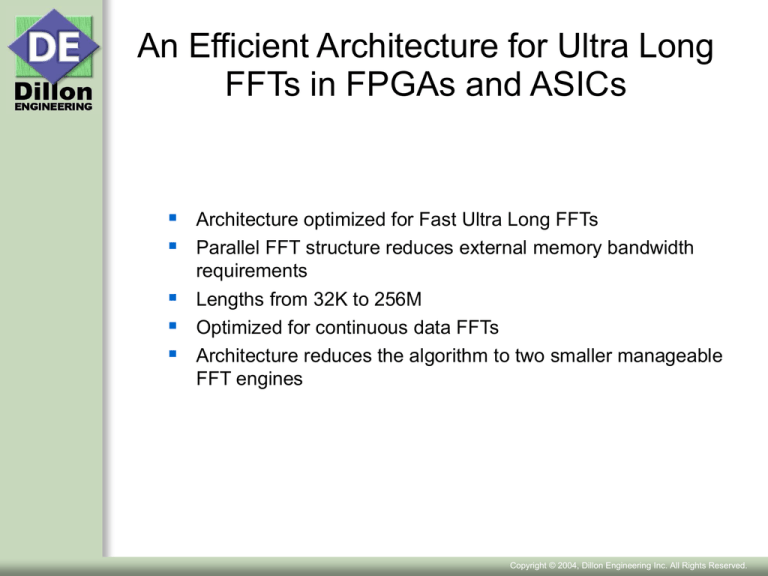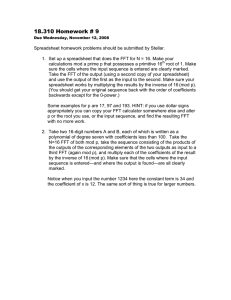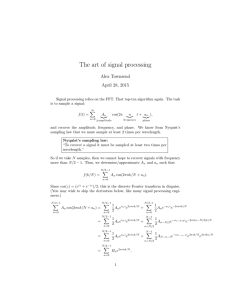
An Efficient Architecture for Ultra Long
FFTs in FPGAs and ASICs
Architecture optimized for Fast Ultra Long FFTs
Parallel FFT structure reduces external memory bandwidth
requirements
Lengths from 32K to 256M
Optimized for continuous data FFTs
Architecture reduces the algorithm to two smaller manageable
FFT engines
Copyright © 2004, Dillon Engineering Inc. All Rights Reserved.
Ultra Long FFTs
An FFT length that exceeds the internal memory requirements of the
FPGA or ASIC
System cost can be reduced in moderate length FFTs in designs
where the FPGA/ASIC size is driven by the memory
requirements.
This architecture puts most of the storage for the FFT off chip in
relatively inexpensive SRAM, reducing the system cost.
Ultra Long FFTs have a similar structure to 2D FFTs
Cooley-Tukey algorithm
Minimizes external memory IC count and bandwidth
Copyright © 2004, Dillon Engineering Inc. All Rights Reserved.
What Ultra Long FFTs Need
The following shows the execution unit (logic) and memory
requirement for continuous data FFTs of two lengths:
The logic requirements for a 1M FFT are only double a 1K FFT,
while the memory requirements are 1000 times.
Logic for 1M FFT easily fits into large FPGA
Memory requirements exceed what is available even in a large
FPGA
Copyright © 2004, Dillon Engineering Inc. All Rights Reserved.
Computing N = N1 x N2
The N1 x N2 FFT can be computed as:
Computing this for:
and
Results in:
for
as desired
Copyright © 2004, Dillon Engineering Inc. All Rights Reserved.
N = N1 x N2 Architecture
E xt QDR
E xt QDR
E xt QDR
Twiddle
Multiply
N 2 FFT
N 1 FFT
Out
In
Matrix
Transpose
Matrix
Transpose
Matrix
Transpose
Three banks of external QDR Memory (single copy each)
Two continuous data FFTs (N1, N2) inside FPGA
Twiddle Multiply provides vector rotation between N2 and N1
FFTs.
Final matrix transpose for normal order output.
Copyright © 2004, Dillon Engineering Inc. All Rights Reserved.
QDR SRAM
Simultaneous read/writes (separate address/data bus) allow
single bank of memory per memory transpose.
DDR Style I/O so dual clock edge transfer with FPGA results in
narrower data path.
Single copy can be kept at each stage while maintaining
continuous data flow.
Special address sequence employed so data isn't overwritten in
continuous data application. Reduce IC count.
QDR with Virtex II Pro I/O up to 150MHz (read/write)
QDR II with Virtex II Pro I/O up to 200MHz (read/write)
Copyright © 2004, Dillon Engineering Inc. All Rights Reserved.
CORDIC For Twiddle Factors Generation
Almost N/2 twiddle factors required.
Very large ROM for FPGA or ASIC.
CORDIC a natural fit, use coordinate product as input.
Complex
M ultiply
FN2[n1,n2]
n1
n2
Coordinates
Multiply
CORDIC
CORDIC produces the sin/cos terms for angle input.
Copyright © 2004, Dillon Engineering Inc. All Rights Reserved.
Matrix Transpose Address Sequence
Allows single copy for each matrix transpose.
Operates on continuous data, one point read/written per clock cycle.
Reduces memory IC count.
Simple logic for sequence generation.
Works for square or rectangular matrices.
Sequence repeats after log2(N) sets.
Write always follows read.
Simple N = N1 x N2 = 8 example:
First and last matrix transpose go left to right in table, second right to
left.
Copyright © 2004, Dillon Engineering Inc. All Rights Reserved.
Fixed vs. Floating Point
Numbers in radix-2 FFT can grow by log2(N), or 1 bit per butterfly
rank.
A 1M FFT can have 20 bits of growth. With 16 bit inputs results
would be 36 bits.
Scaling always required in fixed point versions.
Fixed point scaling should be limited to every to every other rank,
so 10 times for a 1M FFT producing 26 bit results from 16 bit
input.
Floating point FFT maintains precision without overflowing.
Floating Point FFT uses approximately 8 times the logic of a
similar precision fixed point version.
Copyright © 2004, Dillon Engineering Inc. All Rights Reserved.
Virtex II Pro Performance – 512K FFT
80MHz Continuous Data
1K FFT Engine – 4 butterflies
512 FFT Engine – 4 butterflies
FFT Engines at 160MHz
QDR memory at 80MHz
Real 14 bit input, complex 24 bit output
Virtex II Pro – Device Usage
Slices - 12,500
BlockRAM - 144
MULT18x18 – 88
Fits in XC2VP40
Copyright © 2004, Dillon Engineering Inc. All Rights Reserved.
Other Uses of Architecture
2D FFT – Remove first matrix transpose and twiddle multiply.
Variable Length – Use variable length FFTs and dynamic matrix
transpose blocks.
Mixed Radix FFTs – Substitute other than radix-2 for 2nd FFT.
Performance increases easy with parallel input radix-2 FFTs and
multiple paths to SRAM.
Copyright © 2004, Dillon Engineering Inc. All Rights Reserved.
Other Dillon Engineering Resources
ParaCore Architect (parameterized core builder)
DSP Algorithms
Mixed radix FFTs
2D FFTs for image processing
Fixed or floating-point FFTs
Floating point math library
AES Cryptography
System level DSP
OFDM Transceivers
Radar Processing on single FPGA
Image Compression/Processing
Hardware/Software SOC
High speed Ethernet Appliances
Linux Based SOC in FPGA
MicroBlaze application
Copyright © 2004, Dillon Engineering Inc. All Rights Reserved.




